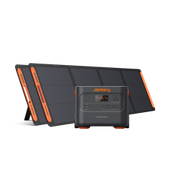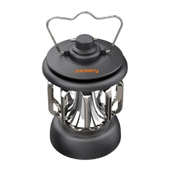Ice fishing is a beloved winter pastime for millions of Americans across northern states. As soon as the lakes and ponds freeze over, dedicated anglers start gearing up for another exciting ice fishing season. The sport continues to grow in popularity each year as more people discover the joys of drilling through the ice, lowering their line, and catching fish in the frigid conditions.
In this ultimate guide for beginners, we’ll cover everything you need to know to get started with ice fishing. What's more, no ice fishing excursion is complete without understanding the importance of solar power stations and heat sources to keep you comfortable on the ice all day.
After reading this guide, you’ll have all the knowledge needed to get hooked on this thrilling winter sport. So, let’s get started!
Ice Fishing in the US
Ice fishing is quite popular among people in the United States. Let's explore more about how popular it really is.
History and Cultural Significance of Ice Fishing
Ice fishing has played an integral cultural and sustenance role across the northern United States for centuries. Historical accounts show Native American tribes like the Dakotah and Chippewa relying on ice fishing to provide vital food through harsh winters long before European settlers arrived.
Over time, these pragmatic winter bass fishing origins transformed into a recreational escape and cherished social activity to cure cabin fever. The practice of carving holes into frozen lakes united communities and became a common winter pastime. Derbies and tournaments began popping up; the white ice also allowed easy access to remote areas only reachable by boat in summer.
By the mid-20th century, ice fishing’s legacy secured its status as a beloved regional tradition across the upper Midwest and New England.
Popular Ice Fishing Destinations in the US
The top states and regions for ice fishing remain concentrated across the upper Midwest and northeast. Minnesota reigns supreme as the winter fly fishing capital. With over 15,000 lakes and dominant winter seasons, Minnesota boasts the highest participation by far. Close seconds, Wisconsin and Michigan also offer exceptional hard water angling opportunities.
Beyond the top trio lies sleeper ice fishing locations like New York’s Finger Lakes, Maine’s Belgrade Lakes region, and high mountain lakes in Colorado. Wherever consistent winter freeze occurs, devoted anglers are sure to follow. Popular target species range from panfish like crappie and bluegill to trout, walleye, northern pike, and even muskie.
Seasonal Ice Fishing Windows
Ice fishing season varies slightly across different latitudes but generally runs from mid-December through late February or early March. The determining factor is ice thickness in lakes and ponds. Safe ice depth for anglers begins around 4 inches, yet many wait for double that thickness before venturing out.
Smaller bodies of water with less current tend to freeze quickest while fast-moving rivers and streams take longer. Cold weather patterns are also ideal for quick ice development vs. fluctuating warm spells. Peak times across the Upper Midwest usually fall in January and early February when thick ice can reliably form. Far northern states like Maine see a bit longer with potential ice fishing from December through March.
Ice Fishing Regulations and Permits
Ice anglers should familiarize themselves with local regulations before dropping their first line. Most states require standard fishing licenses, though some offer designated stamps. This includes Minnesota's winter fishing license add-on and New Hampshire's freshwater ice fishing registration. Common special regulations pertain to shelter guidelines, rod numbers, bait rules, possession limits and slot sizes depending on the target species.
Ice shelters have specifics like they must be removed after season's end and have visible owner ID tags. Number of lines/rods are often restricted to two or three per angler. Live bait, such as ice fishing flies use, can be limited in certain fisheries. It's imperative to know the rules on ice thickness, too – usually ranging from 4 to 6 inches for occupancy. Checking statewide fishing guides protects anglers and the resources for sustainable future seasons.
Tips for Successful Ice Fishing
Are you ready to go ahead with ice fishing? If so, you need to keep a few important tips in mind. It will help you to get the most out of your ice fishing adventures.
Choosing the Right Ice Fishing Location
Selecting the best possible lake or reservoir gives beginners an advantage right from the start. Focus your search on bodies of water holding abundant panfish like crappie, bluegill, yellow perch, and sunfish. These fish swarm smaller waters in almost all ice fishing states and readily bite a well-presented offering.
Natural lakes with shallow weed flats that freeze quickly make exceptional starter spots, too. The vegetation shelters both baitfish and predators, leading to hot action once located. More esteemed walleye factories across the Midwest represent tougher challenges for rookies but some reservoirs have beginner-friendly action.
No matter what the target species is, sufficient ice thickness determines everything in ice fishing. Stick to frequently measured and reported lakes, or avoid guesswork altogether by hiring a guide the first few times out. Look for a solid 8 inches of ice at minimum to ensure safety and peace of mind when navigating your fishing hole.
Techniques and Strategies to Follow
- Best times of day to fish
The early morning and evening dusk periods tend to generate the most consistent bites during ice fishing. After overnight cooling and before the warmest hours of the day, fish become more active in the marginal lighting conditions. Carrying a portable shelter allows anglers to capitalize on this peak activity from a dark, enclosed space.
- Bait and Lure Recommendations
As for tackle, keep offerings as simple and small as possible for panfish. Mini ice jigs tipped with waxworms, mealworms, or tiny soft plastics work exceptionally well for lighting up their bite. Crucial accessories include a skimmer to keep the hole clear of slush and ice chips, along with an ice auger blade sharpener for fresh cut holes.
However, no winter fishing excursion comes with guarantees. Ice anglers must blend patience with adapting strategies if the fish shut off the early bite. That may mean downsizing lures, changing color and profile preferences, or even moving to an entirely new spot. Flexibility and persistence eventually lead to unlocking the formula to put fish on the ice!
- Embracing Winter Conditions
Beyond catching loads of fish, embracing winter's serene beauty and isolation ranks among the top motivations for ice anglers. Preparing properly allows enthusiasts to soak in the tranquility of nature's winter wonderlands from the comfort of heated shelters when bites cease.
Don’t let harsh conditions deter you from enjoying some of fishing’s finest hours during the ice season. With the right game plan and gear-up, the rewards of ice fishing make tangling with Old Man Winter well worthwhile for most fishermen.

Essential Gear for Ice Fishing
You need to be equipped with the right gear for ice fishing. Let's take a quick look at the gear you should buy to go ahead with it.
Choosing the Ideal Ice Rod and Reel
Specialized ice rods and reels designed for finesse presentations underpin every successful frozen water excursion. Shorter one-piece rods below 3 feet excel for providing sensitivity plus the needed leverage to pull stubborn panfish through 10-inch holes.
A comfortable pistol grip configuration also works well when maneuvering rods in tight confines. As far as reels, models with reliable drag systems, instant anti-reverse, and smooth ball bearings optimize performance in the cold. Pick an outfit suited to your target fish class for an ideal balance of sensitivity and brute power.
Tip-Ups and Traps – Automatic and Setline Options
Beyond traditional rods and reels, other handy gear helps capitalize on multiple bites at once. Tip-ups act as mini flag alarms, signaling strikes, and fish runs as they unfold. Anglers simply lower bait like minnows or shiners to desired depths, set the trigger and wait for flags to fly up.
Exciting visibility from a distance makes tip-ups a fun introduction for young ice anglers, too. For trout and panfish fans, try more enticing options like small ice fishing traps that dangle multiple baits in the strike zone at once with instant hook sets.
Insulation and Apparel – Conquering Sub-Freezing Endurance Tests
No aspect matters more for enduring icy environments than choosing adequate ice fishing apparel. Purpose-built thermal base layers that actively draw moisture away from the skin now feature extensively in most ice anglers’ kits. Wool, fleece, and modern synthetic materials like polyester and nylon make up middle insulating layers before topping off with a rugged outer shell jacket. For maximum warmth minus bulk, snag bib fishing pants with built-in boots from trusted cold weather brands.
Don't forget anti-slip cleats that strap onto boots for navigating slippery ice on foot. Small additions like heated gloves and insoles also bump comfort levels exponentially in the cold for marginal extra investment. Lastly, always pack an extra errand of dry gloves and socks in case water somehow sneaks past your protective barriers.
Accessories to Get
A well-prepared ice angler ensures their gear arsenal contains a full suite of vital accessories for fishing and safety. Handy items include an ice skimmer for cleaning slush from holes, sleds for hauling equipment, shade covers and tents for portable shelter options, and ropes with float bags for rescuing gear from lost ice holes.
Must-have items for the tackle box feature an ice fishing depth/fish finder, underwater cameras, specialized plastics and ice jigs, and standard hooks, lines, and weights.
Portable Power Station
Of course, sufficient onboard power represents the linchpin, making all accompanying electronics and accessories possible. Investing in a rugged portable solar power station built specifically for off-grid ice fishing makes winter sorties exponentially easier.
Reliable, pure sine wave power protects sensitive gear while delivering the juice you need for augers, cameras, fish finders, and critical battery backup when extreme cold zaps charge faster. Don't head onto the winter practice field without one!
Power Up Your Ice Fishing Experience with Jackery
Reliable power tops the list of vital components for next-level ice fishing adventures. Jackery offers cutting-edge portable power stations packing plenty of juice and output to handle demanding cold weather conditions. Our compact Explorer models provide off-grid power ideal for ice anglers.
Jackery Explorer 1000 v2 Portable Power Station
The Jackery Explorer 1000 v2 Portable Power Station delivers 1070Wh capacity from a compact, durable design weighing just 10.8 kg. Fast 1.7 hours of rapid recharging through AC and multiple output ports, including AC, USB-A/C, and Carport, give anglers ample flexibility for charging gears on ice.
What’s more, the Jackery Explorer 1000v2 Portable Power Station is able to work at a -10°C low temperature, which means you can bring it to ice fishing areas without worries.
Jackery Explorer 2000 v2 Portable Power Station
For hardcore enthusiasts demanding maximum energy reserves, the Jackery Explorer 2000 v2 Portable Power Station bumps capacity up to a mammoth 2042Wh. Housed in a still easily portable 17.9 kg unit, its extreme cold kit enables flawless output down to 10 °C conditions. It can run high-draw ice fishing electronics nonstop, ensuring successful fishing.
Both Jackery power station options explorer feature next-gen batteries, advanced LCD displays, and overload protection for worry-free wintertime use. Simply layer up the included outlet ports with heated gloves, ice flashers, cameras, and other electronics to take your ice fishing game into another stratosphere this season!

Conclusion
Following these tips on ice fishing for beginners can help you to go ahead with ice fishing and enjoy it to the fullest. Just be sure to respect safety protocols and proper training before hitting unfamiliar hard water.
With our well-equipped solar generators leading your gear arsenal, both gear and angler stay energized no matter the weather. Apply the lessons contained in this guide to claim your own ice fishing spoils this year. Soon enough, you also can adopt the alternate winter lifestyle chasing flags and underwater cameras signaling the specialty catch gliding across the screen.



















































































































Leave a comment